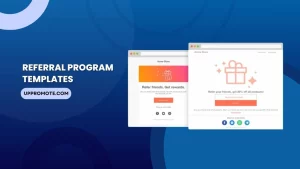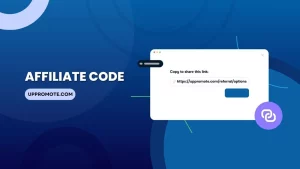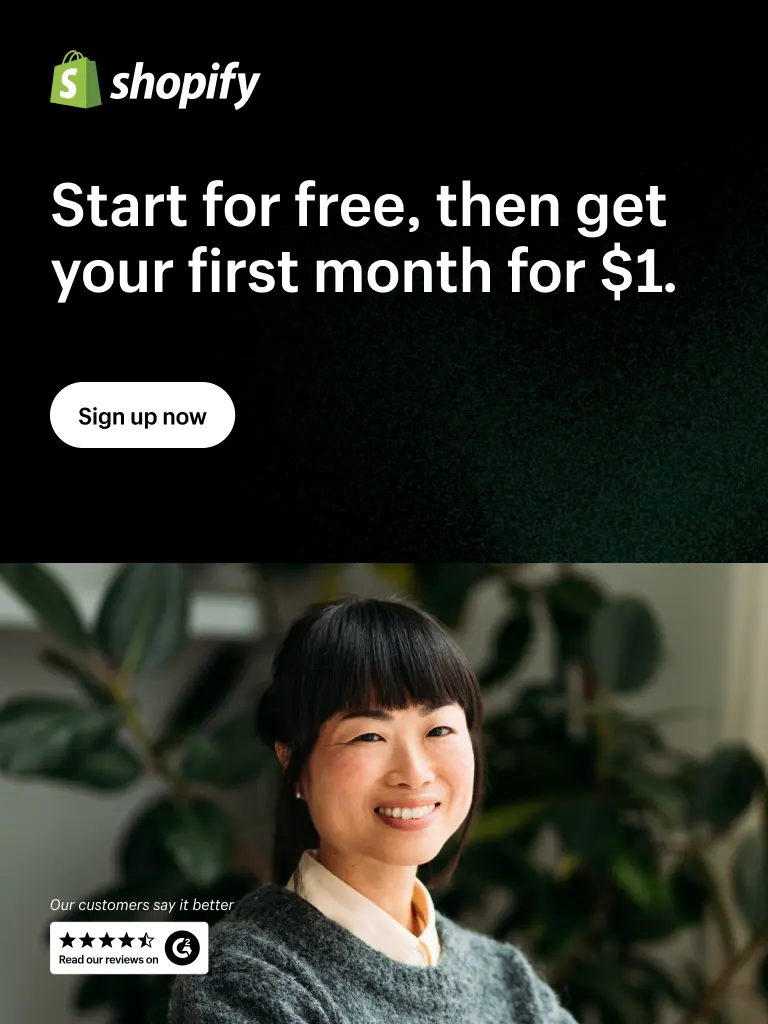Did you know referral marketing is a strategy that relies on trust and mutual benefit? Essentially, when a satisfied customer refers a friend or colleague to a business, there is an inherent trust that traditional advertising has difficulty achieving.
Typically, this process involves a referral program where existing customers are incentivized to bring in new clients. The success of referral marketing is based on a simple but powerful concept! What? In fact, everyone is more likely to trust recommendations from a list of people they know.
This method reduces customer acquisition costs and increases loyal clients. The reason: customers feel valued and part of the brand’s community. So how can the merchant take advantage of this effective marketing? Keep reading!
What Is Referral Marketing?
Referral Marketing is a manner to encourage your current customers to refer new customers to merchants. It’s a situation where everyone wins: your customers become your supporters, and you get new customers.
There are five main types of referral marketing:
- Direct Referral. Customers directly recommend the business to their friends or family.
- Incentive-Based Referral. Customers are offered incentives or rewards for successful mouth referrals.
- Social Media Referral. Customers share their positive experiences or referral codes on social media platforms.
- Email Referral. Businesses leverage email marketing to encourage customers to refer their friends.
- Non-Incentive Referral. Customers recommend the company without receiving rewards or incentives.
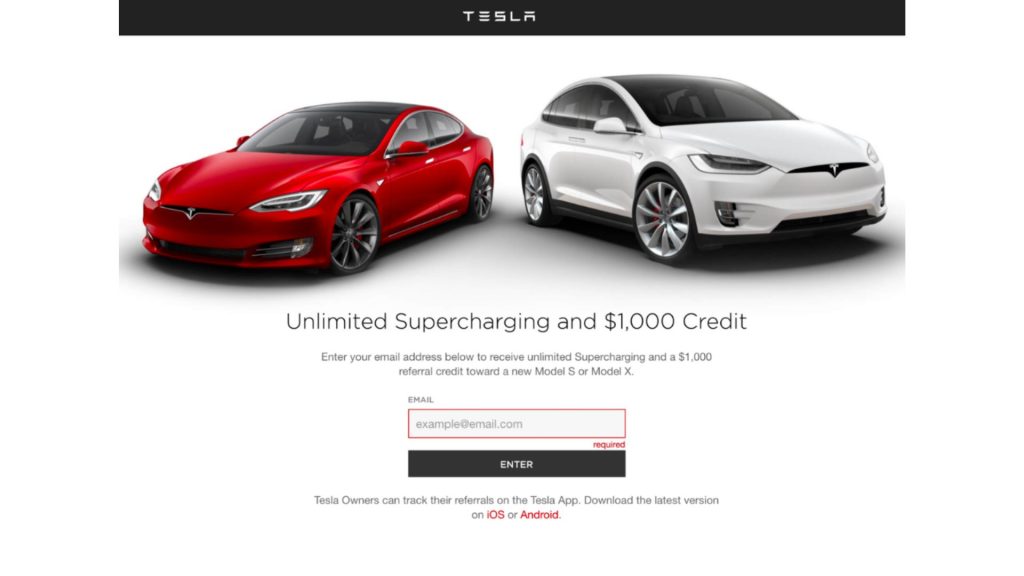
For example, Tesla is a company that sells electric vehicles and clean energy. If a Tesla owner refers friends to buy Tesla vehicles using a referral link provided by the owner, the owner can receive up to a US$1,000 discount on their next purchase or service.
How Referral Marketing Works
Before learning about the referral marketing process, you must know about the participant entries! Plus, you must have a deep understanding of their responsibilities.
- The referrer is a person who recommends a product or service to others and shares their positive experiences. Their job is to also provide the necessary referral information, such as a referral code, to the referee.
- The referee is the person who has been referred to the product or service. They use the referral information the referrer provides to purchase or sign up for the product or service.
- Business: This company offers the product or service. Their tasks include:
- Setting up the referral program, including deciding on the rewards or incentives.
- Promoting the referral program to potential referrers.
- Track referrals and ensure that rewards are distributed appropriately.
- Following up with both referrers and referees to encourage further referrals.
- Regularly analyzing and optimizing the customer loyalty program.
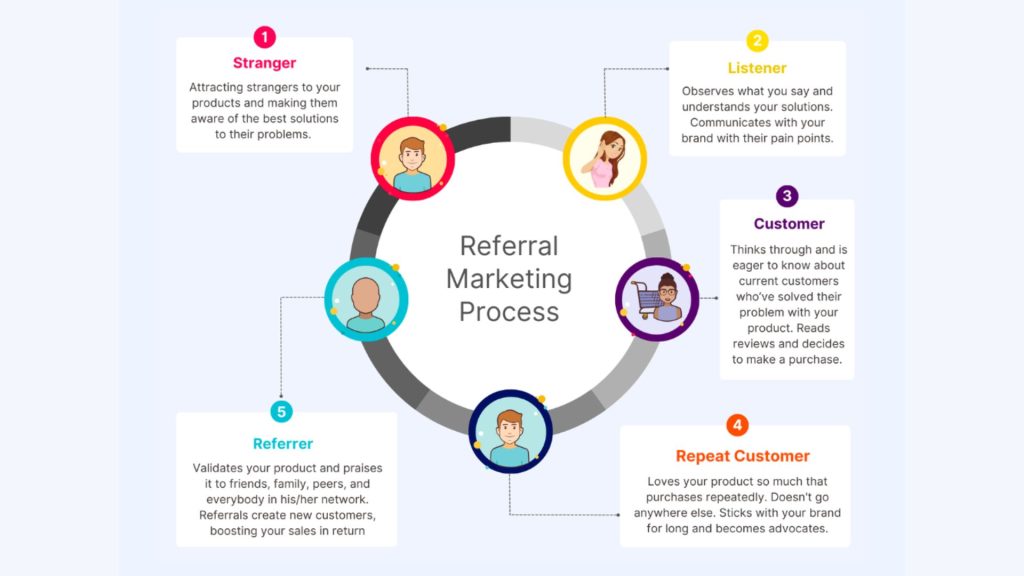
Let’s analyze the process through the example of Duolingo! It is a popular app that helps people learn new languages.
To start, Duolingo attracts people who don’t know about the app. They do this through social proof or direct invitations. These people become users, and then they become repeat customers if they like the app.
Eventually, these happy customers, as referrers, tell their friends about Duolingo! After their friend joins the app, the referrer will get rewarded for getting a week of free premium access.
How To Get Referrals from Your Customers: 10+ Effective Ways Worth Trying
As the merchants, we believe you will want to get more users and build stronger relationships with existing ones. How to do that? Below are the 10+ effective ways to get customer referrals!
Go beyond customers’ expectations.
A superior product is not always enough to acquire customer reviews and business referrals in today’s competitive market. Therefore, it is crucial to provide more help to your customers.
You can do this by reminding them what they should do next or giving them a few extra tips on using the product better. It doesn’t mean you have to break the bank or go overboard! Just being helpful can be enough to get you a stellar review and a business referral.
If you have already been paving the way for referrals, that’s great. You may have some word-of-mouth referral marketing working in your favor! And new customers are coming in. However, to take things to the next level, you must create an organized strategy to increase your referrals further.
One way to do this is always to try to deliver more than what you’ve promised. It could be in the form of better quality, faster delivery, or additional perks.
Doing that will exceed your customers’ expectations, increasing the likelihood of them referring your business to others. Therefore, going the extra mile is essential to create a positive customer experience.
Know when should ask
Getting referral requests and online reviews can be a critical factor in the program’s success. However, many merchants fail to capitalize on this opportunity simply because they don’t ask their customers.
Suppose you are confident that you provide exceptional products or services and have even received positive customer feedback. In that case, all it takes is a simple request for them to share their opinion.
So, are there any considerations when asking customers? It’s essential to approach it customized.
- Avoid asking for a referral when you are still in the process of creating deliverables! Or even if you have missed the mark on something.
- Keep your clients in the loop about the successes they achieve through your company.
- Share success metrics with your clients to show your impact.
- Coordination with other departments of your company can also help you know the right time to reach out.

However, the truth is not the same as a dream! The approach of requesting a referral can put your customer in a difficult position. Instead, why don’t you teach them how to refer you?
You can start with your best customers, as they are the ones you want to clone. Once you’ve finished providing your services, you must tell people that referrals are fundamental to your business.
You shouldn’t just say that you’re looking for new clients but involve your current clients in your accomplishments by requesting their advice. It will make them feel important and committed to your triumph.
Moreover, you can encourage your clients to think about other professionals in their network who might be encountering comparable difficulties to the ones you’re dealing with. It’s important not to be too forceful but subtly inspire them to refer others to you.
Create a referral program
The next step is to create a successful referral program!
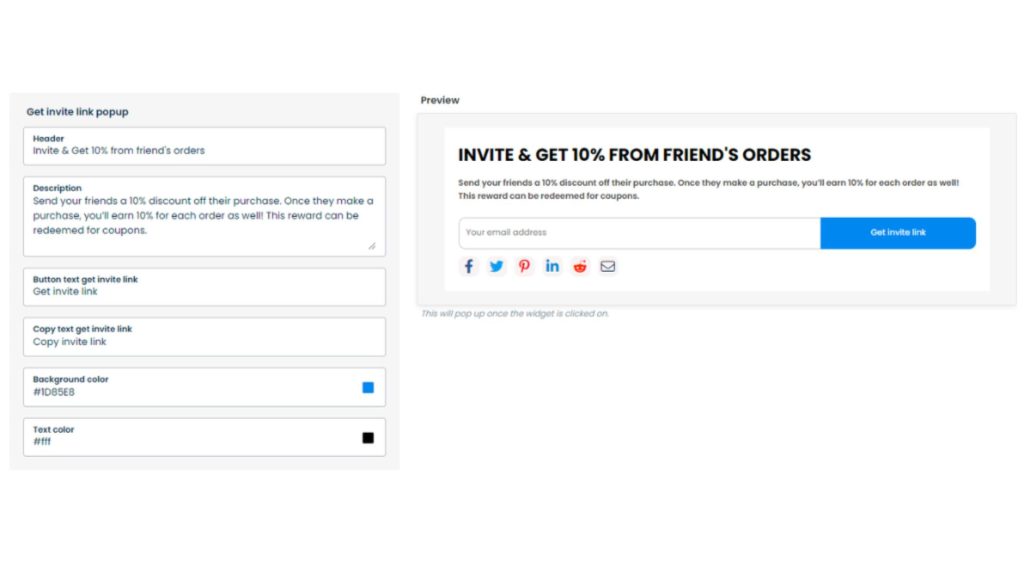
One of the best options we recommend is UpPromote. Why? Because the merchants can find any feature for the referral program in this tool! Some include
Easy-to-setup referral program
- Activate or deactivate the program easily with just one click.
- Customize the reward and discount amounts with ease.
Noticeable widget on your website
- A widget will be displayed on the website! So it is easy for customers to share referral links.
- You can choose where to position the widget on your website and customize its color and text settings.
Potent rewards for customers and referred friends
- Customers will receive a flat rate or percentage-based reward per order.
- Referred friends will receive a fixed amount, percentage, or free shipping discount.
In-depth reports
- You’ll receive a graphical report on conversions, which you can filter by date and time.
- You can view reports on clicks, sales, referrals, and commissions for each customer.
- Successful referrals can also be viewed.
Prompt email notifications
- Reward emails are sent instantly.
- Coupon codes are easy to redeem.
- You can customize email content and appearance.
Sales booster
- This program can increase brand awareness and grow sales.
- Both customers and their friends can enjoy appealing discounts.
As you can see, in the market, UpPromote is defeating all competitors and becoming the #1 tool for supporting merchants in managing their programs!
Add your referral program to your website,
Adding a referral program to your website is the next step to increase visibility.
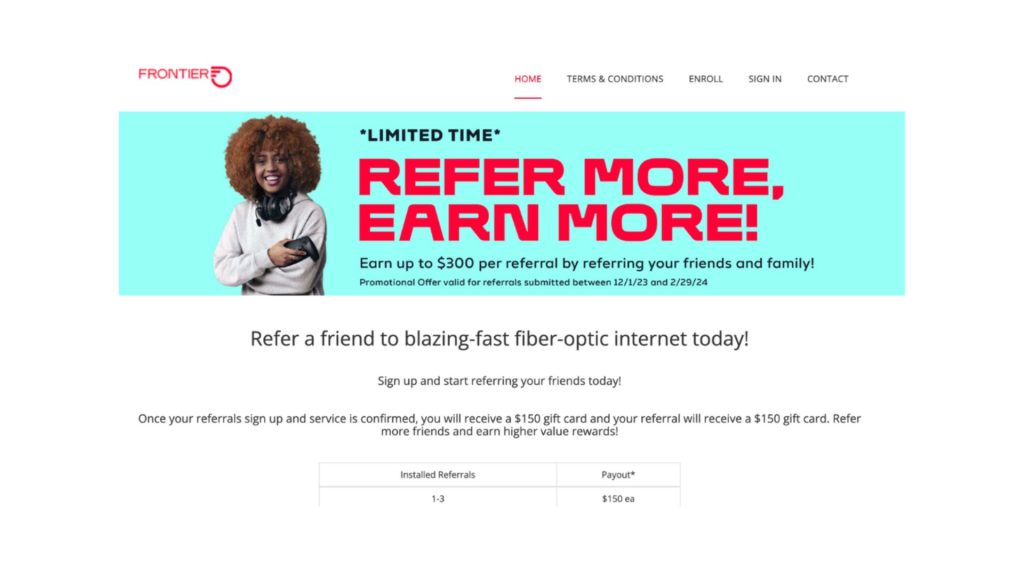
To do this effectively, there are some steps and strategies you should consider:
- Choose the Right Location. The referral program should be easily accessible from any page on your website. Merchants can add it to the main navigation menu, footer, or as a pop-up.
- Create a Dedicated Landing Page. A dedicated landing page for the referral programs can provide all the necessary information about the program! Some include how it works, the benefits, and how to sign up.
- Use Clear and Compelling Call-to-Actions (CTAs). Examples of CTAs, include “Refer a friend and get 20% off” to encourage customers to participate in the referral program.
Considering these tips can make your referral program as visible and accessible as possible. In turn, it will make it easier and more enticing for customers to refer others, ultimately helping the merchant grow the business.
Conduct market research
Market research is crucial in creating an effective customer referral program. Here’s how to conduct market research specifically for this purpose:
- Identify Your Target Audience. Understand who your customers are and what they value. It will help you tailor your referral program to meet their needs and preferences.
- Understand Customer Behavior. Analyze your customers’ behavior to understand when and why they refer others. So you can identify the best time to ask for referrals.
- Survey Your Customers. Merchants should use surveys to gather customer feedback about the existing referral programs. Ask them what they like, what they don’t like, and what incentives would motivate them to refer others.
- Analyze Your Competitors’ Referral Programs. Look at the referral programs of your competitors. What strategies are they using? What incentives do they offer? It can give you ideas for your program.
- Test Different Strategies. Use A/B testing to try different referral strategies and see which works best. Therefore, merchants can optimize your referral program.
Market research aims to gather information to help you make informed decisions about your referral program. By understanding your customers & their preferences, you can create an appealing and effective referral program.
Always provide value
You should understand what your customers truly value if you want to ask them for a referral. By doing research, you can align your incentive or acknowledgment with those values. After that, giving them an idea of their impact with a referral is a good idea.
Let’s see an example!
Suppose customers use your product for nonprofit fundraising or are passionate about a cause. In that case, you can make them feel even more appreciated by rewarding them for referrals with a donation in their name.
This little act of kindness can help build a stronger relationship with potential customers & and show them that you care about more than just business. When they see that you share their values and interests, they’ll likely want to spread the word and refer others to your fantastic service!
However, being genuine about having these values and not just using them to benefit your business is important. Customers can tell when the attempts are inauthentic! And they won’t hesitate to talk about it with others. So, ensuring you’re genuinely invested in these values before using them as an incentive.
Build long-lasting relationships with customers
Should you focus on getting to know your customers instead of vice versa? Well, having loyal customers is hard, but building long-lasting relationships with them is harder!
Let’s take an example of selling eco-friendly products through carbon-neutral methods for human nature. Here’s how this approach can help build customer loyalty:
- Shared Values: Environmentally conscious customers will likely be attracted to businesses that share their values. By selling eco-friendly products and using carbon-neutral methods, you show these customers that you share their commitment to the environment.
- Rewarding Eco-Friendly Behavior: Offering rewards for eco-friendly actions! Some include going cashless, which can further strengthen this relationship. It incentivizes eco-friendly behavior and shows your customers that you value their efforts.
- Celebrating Environmental Milestones: Celebrating occasions like Earth Day through sales and seminars can educate your customers about the importance of environmental sustainability. It can help build a community around your brand and deepen customer relationships.
- Sustainable Loyalty Programs: A green loyalty program promoting sustainability can help improve customer engagement. For example, you could give your customers trees as gifts or create a corporate forest.
However, it’s important to note that building long-lasting relationships with customers requires more than just shared values and rewards. It requires consistent effort, excellent customer service, and a genuine commitment!
That’s why building these relationships can be challenging, but customer loyalty and advocacy rewards can be well worth the effort.
Offer attractive incentives
It’s a well-known fact that nobody likes to work for free. So, if you want your customers to search for potential clients for your business actively, you need to offer them something valuable in return.
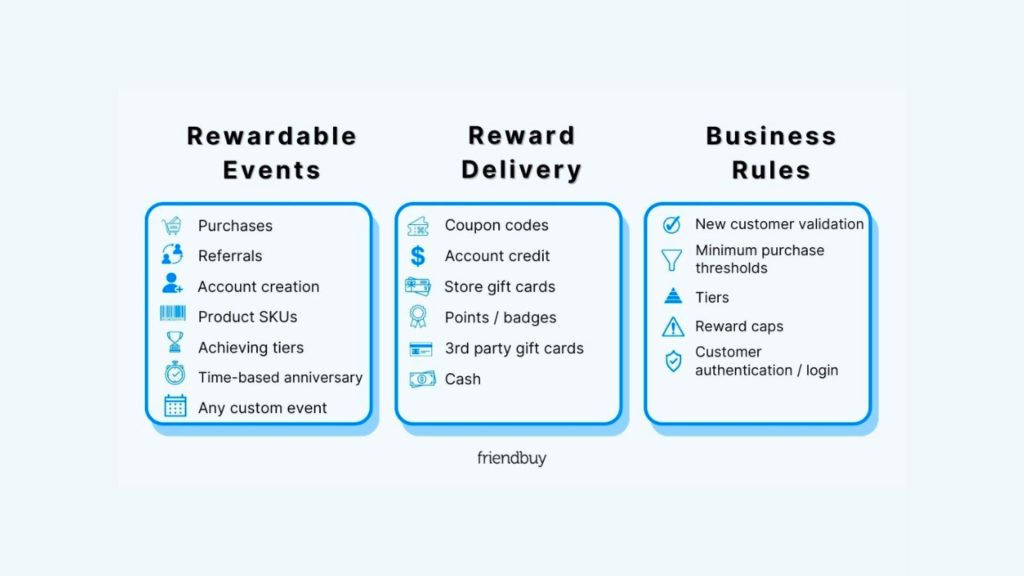
Here are some common types of referral incentives:
- Cash Rewards: This is a direct and universally appealing incentive. Customers receive a cash reward for each successful referral, which can even attract non-customers to refer others. You must ensure that the reward value is less than the value of a new customer to your business.
- Discounts or Coupons: Discounts or coupons can be an excellent incentive, especially if the discount is significant.
They encourage referrals and incentivize the referred friend to make a purchase. The discount or incentive merchants offer must be less than the value of a new customer to your business.
- Free Products or Services: Offering free products or services can be a great incentive, especially if your customers highly value the product or service. It helps build trust with a growing audience.
- Charitable Donations: Some businesses donate to a charity of the customer’s choice as a referral incentive. It ensures a positive image for your business and builds community between prospects and customers.
- Exclusive Access: Accessing exclusive and valuable content, products, or experiences can be a powerful incentive. It could be a unique URL used in referral marketing programs companies provide to their existing customers to promote their brand and products.
- Points, Rewards, or Loyalty Programs: Customers earn points or rewards for each referral, which can be redeemed for various benefits. In a loyalty program, customers earn points for every purchase. Once several loyalty points are accumulated, they can be redeemed for free products, cashback, or other reward perks.
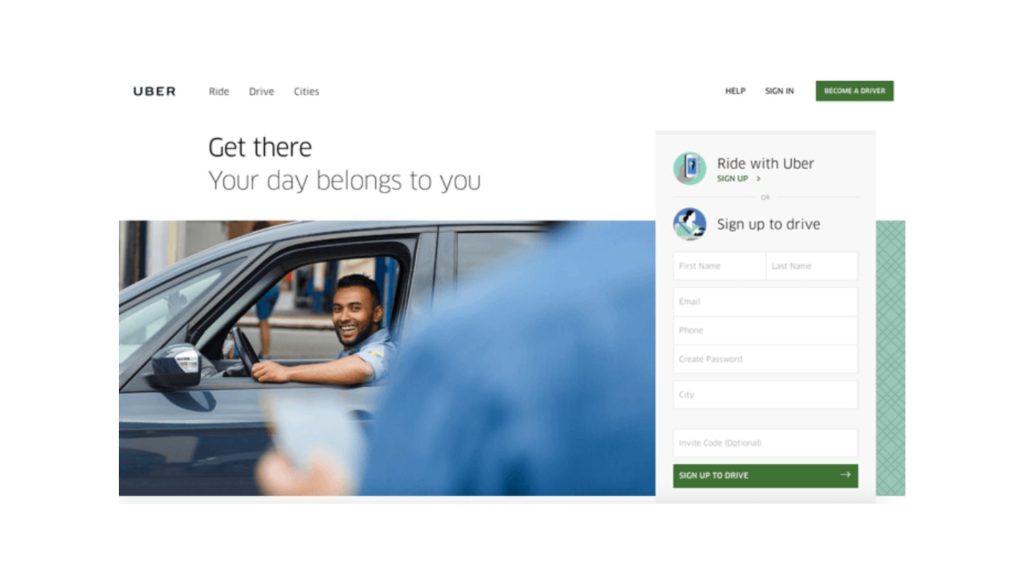
For example
In part, Uber’s success can be attributed to its referral program. By offering both the referral client and the referred individual free rides, Uber was able to leverage the power of incentives to drive massive growth.
The program was simple, easy to understand, and provided a tangible benefit to both parties. As a result, Uber’s referral program became a significant driver of customer acquisition, helping the company expand rapidly in various markets worldwide.
You can set up a program that oversees customer referral agreements to simplify tracking and managing these incentives. A referral agreement can help your business generate steady new leads by rewarding influential customers.
Make use of LinkedIn
So surprise? But it actually works!
You can use social media and sales tactics to find second-degree connections interested in your offering! Of course, it won’t cost you anything.
One way to do this is to approach a customer with a specific name or company you want to communicate with. It saves them the hassle of having to think about it on their own. LinkedIn’s Advanced People Search feature is great for finding potential connections.
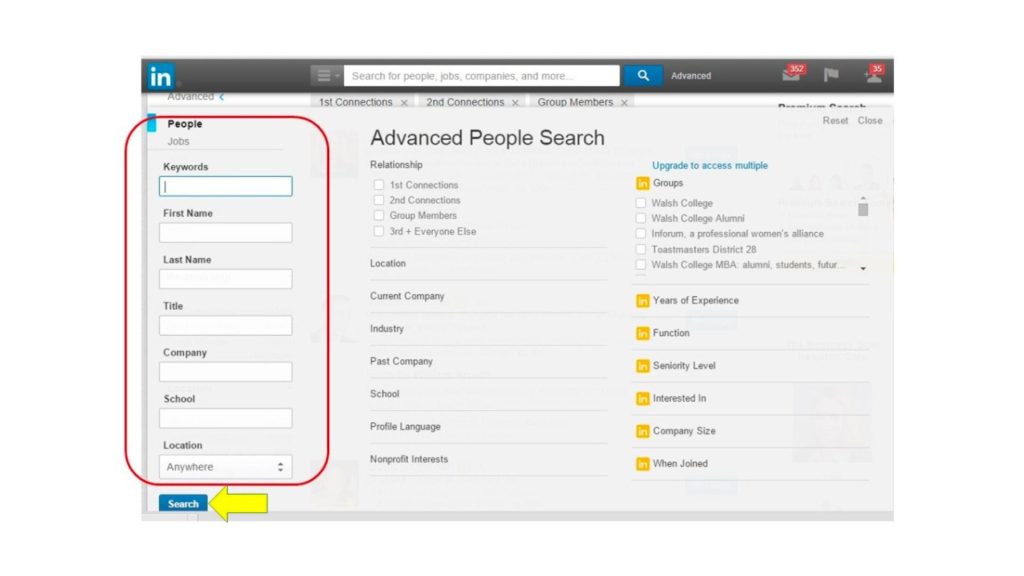
To use it, click on the search bar at the top of the page and select ‘People’ from the drop-down menu. From there, you can filter your search by industry, title, location, and more to find the best referral candidates.
Using LinkedIn’s tools can increase your chances of getting valuable referrals from your network. It is a good way!
Provide referral templates
Referral templates are pre-designed messages or forms that customers can use easily to refer your business to friends, family, or colleagues. These templates can be a powerful way to boost sales and increase customer loyalty.
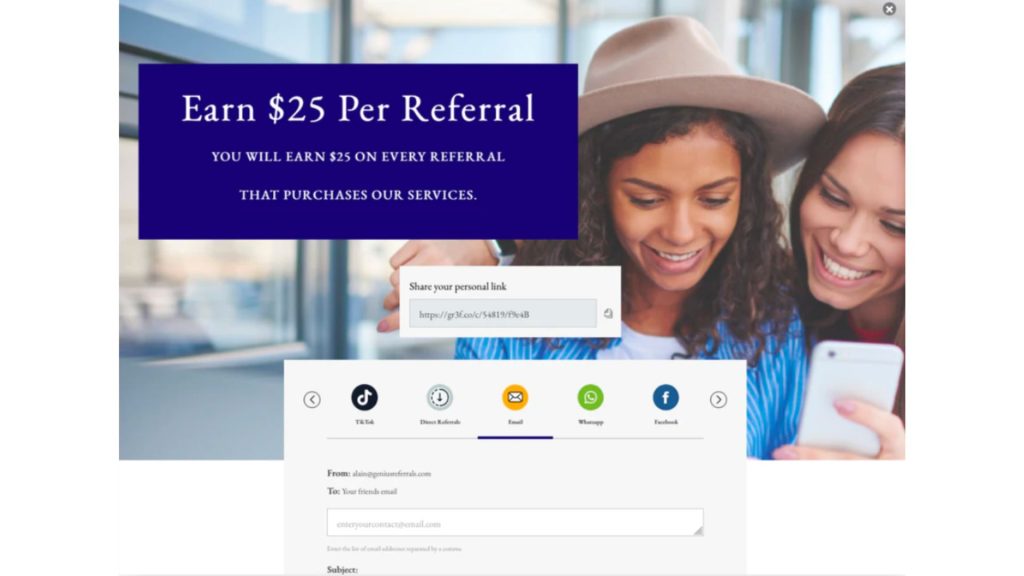
The critical reason client referrals can be so effective is that they come from trusted sources. When a customer refers their friends or family to a business, the referred customer is more likely to purchase because they trust the recommendation.
Referral templates also make it easy for customers to refer others, which can increase the number of referrals a business receives.
By providing customers with a simple & convenient way to refer others, companies can tap into the power of word-of-mouth marketing and potentially see a significant increase in sales.
What factors make a good referral template?
A good referral template should clearly explain the referral program and how to participate. It should also be simple and easy to use. The template should clearly state the benefits of making a referral and allow for some level of personalization to make the referral feel more personal.
Show your gratitude
If you want to stand out from your competitors, showing appreciation for your customers who refer and promote your business is essential.
It’s important to remember that a referral is a gesture that deserves recognition. Let your clients know their time and feedback are valuable. It can be as simple as a phone call, email, or even a handwritten note. The key is to express your appreciation, which will encourage more referrals.
Try different approaches
Asking for customer referrals can be a great way to grow your business, but getting a “yes” from your customers is not always easy. If you encounter resistance when asking for referrals, you first must give your customers some space and respect their boundaries.
It’s not always clear why someone might say no! You should maintain a positive relationship with your customers, even if they’re not ready to refer someone to you.
If some time has passed and you still want to get referrals from your customers, there are other ways to ask for their support.
For example, ask them to write a positive review of your company, serve as a case study, or submit a testimonial. These actions require less effort on the part of your customers than a direct referral, but they still have the potential to drive new leads to your business.
When you ask your customers for feedback, ask them what they feel comfortable sharing. You can use their positive feedback in various ways, such as featuring it on your website or social media channels.
By offering a range of opportunities for your customers to support your business, you increase the chances of getting more referral business in the long run.
Act on feedback
To get more people to refer your business, you need to show that you are worth referring. To do this, you should regularly collect feedback from your current customers to ensure you meet their needs and expectations.
We highly recommend using an online survey referral program software called SurveyMonkey. This tool can support merchants in creating and distributing customer satisfaction surveys efficiently.
Before you send out a survey, it’s good to ensure you are on the right questions in a way that will get the most honest and accurate responses. By doing so, you can identify areas where you need to improve and continue to provide excellent service to your customers.
Benefits of Referral Marketing
We believe that when you read here, you also realize how referral marketing become popular! However, to give you an overview of the picture, we will list the most enormous benefits with proven statistics attached!
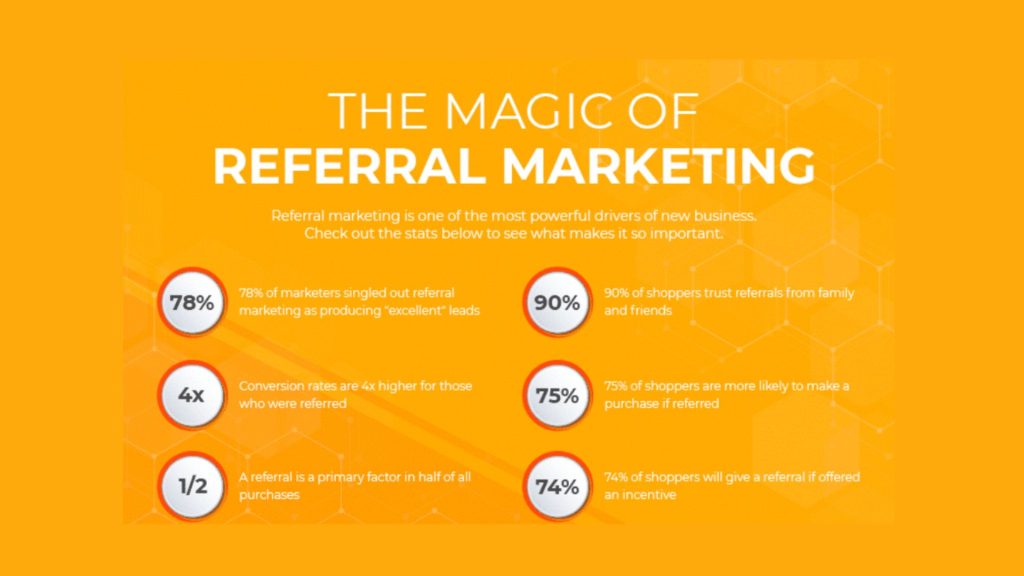
High Customer Retention Rate
Referral marketing is one of the most practical strategic partners to attract new potential customers & retain existing ones. The statistics speak for themselves.
According to Finances Online, leads generated from referrals have a 30% higher conversion rate than leads generated from other marketing channels. Customers who visit your business through referrals are more likely to purchase.
But it’s not just about the initial sale.
Referral leads also have a higher lifetime value than other leads. On average, they are worth 16% more than customers acquired through different marketing channels. This is because referred customers are more likely to stick around and make repeat purchases.
In fact, referred customers are four times more likely to refer your brand to others, creating a cycle of referrals that can continue indefinitely. But perhaps the most compelling statistic is that referred customers have a 37% higher retention rate than customers acquired through other marketing channels.
Increased ROI
Referral marketing is a powerful manner for increasing your business’s return on investment (ROI) in industry trends.
According to Signpost, referred customers significantly impact your profit margin. In fact, referred customers can increase your profit margin by 25%. It is a remarkable gain that can dramatically boost your bottom line.
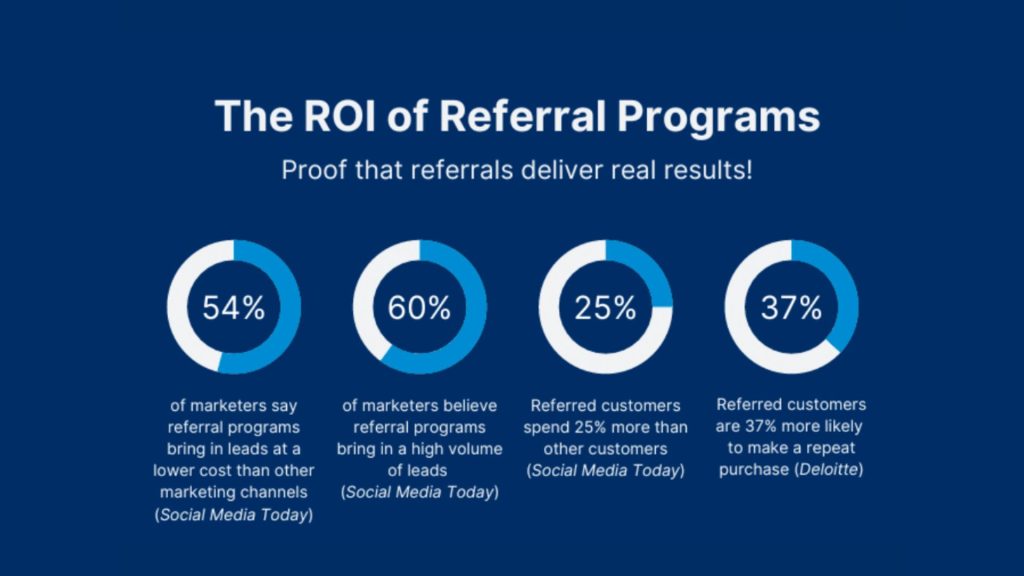
Moreover, referred customers have a higher conversion rate than those generated from other marketing channels. The conversion rate is 30% higher than those from other marketing channels.
So, you can see, the people referred to your business are more likely to become paying customers than those who find your business through other means.
When you consider the increased profit margin, it’s easy to see why referred customers are so valuable. Merchants can expect at least 16% more in profits from referred customers.
Cost-effective
Unlike traditional advertising methods that require significant ad creation and placement investment, referral marketing primarily relies on word-of-mouth and existing customer relationships.
It results in low upfront costs, especially if the referral program is integrated into a company’s existing marketing & customer relationship management (CRM) systems.
Plus, it’s scalability. As your customer base grows, so does your network of potential referrals. It makes referral marketing a cost-effective strategy for small and large businesses. This information can be used to optimize the marketing efforts further, making them more cost-effective.
Viral Marketing Potential
Have you ever heard of viral marketing potential? A marketing campaign can quickly spread and gain popularity through social networks and other online platforms. Like a virus, the message or idea spreads rapidly to reach a large audience.
Referral marketing is an excellent example of a strategy with high viral marketing potential. It enables customers to share a brand’s products or services with their networks in exchange for rewards or incentives. It creates a ripple effect, with each referral leading to new referrals and a rapid customer base expansion.
The best part?
Referral marketing takes advantage of online social networks like Facebook, Twitter, and LinkedIn, making spreading the message and reaching a wider audience easier. When people share a referral or recommendation, it has the potential to reach a massive customers, creating significant viral marketing potential.
FAQs:
- Is it possible to get referrals for free?
Absolutely! Referrals can indeed be obtained for free. Customers sharing positive experiences with your brand, resulting in referrals, is a valuable form of promotion.
Referrals are based on genuine customer satisfaction and trust in your brand, making them especially valuable.
- How to ask for referrals from existing customers?
Asking for referrals from existing customers requires tact and timing. Here are some steps you can follow:
Provide Excellent Service: The first step to earning referrals is to provide a service worth discussing. Potential customers who are happy with your brand are more likely to refer others.
Ask at the Right Time: It’s often best to ask after providing excellent service or when a customer compliments your business.
Make It Easy: Provide clear instructions on how to make a referral. It could be through a referral program on your website or a simple message they can forward to their contacts.
Offer Incentives: Incentives like discounts, freebies, or loyalty points can encourage customers to make referrals.
- How to get referrals fast?
You can speed up the referral process by using all available channels, such as email, social media, and your website!
Conclusion
That’s all! We hope that the question of how to get referrals now is not difficult! This blog post provided you with a detailed definition of referral marketing.
We also highly recommend the top 13 practical manners to boost sales through this type of marketing. After all, with accurate statistics from trusted sources, we once again prove the exceptional benefits and give you worthy pieces of advice!
Thank you for reading!




